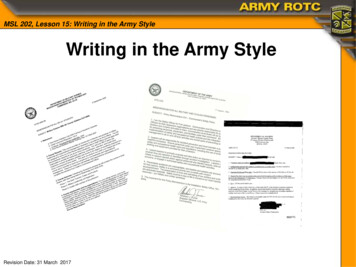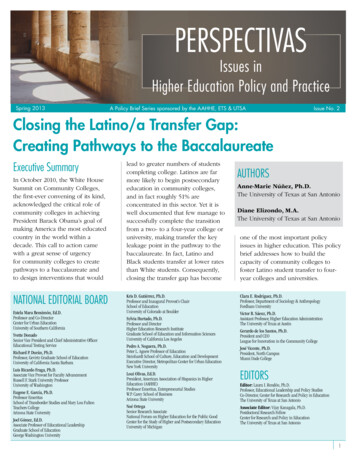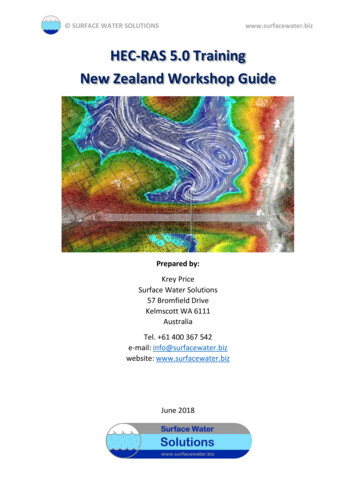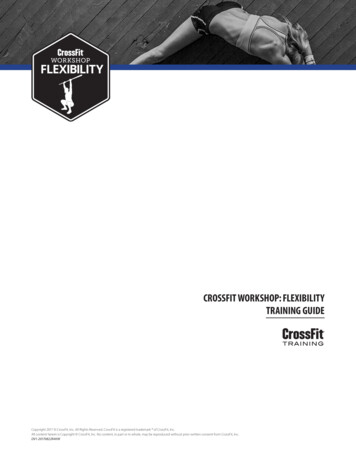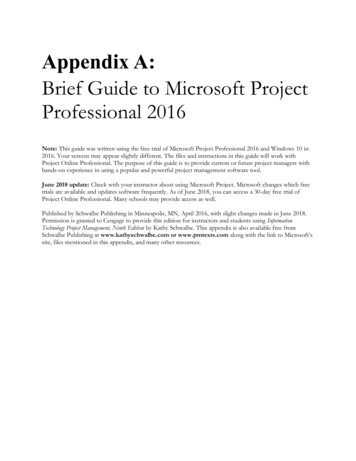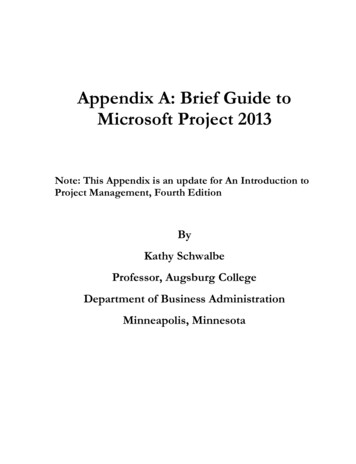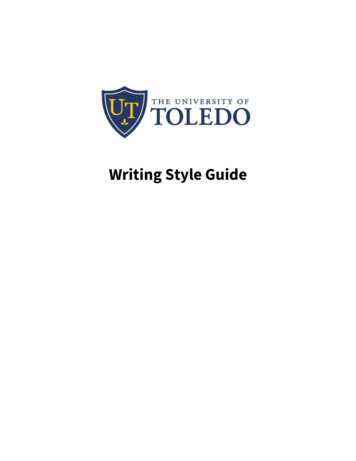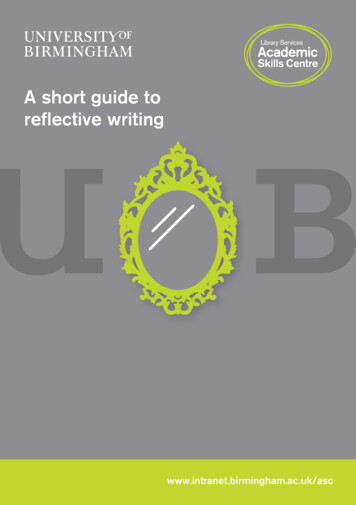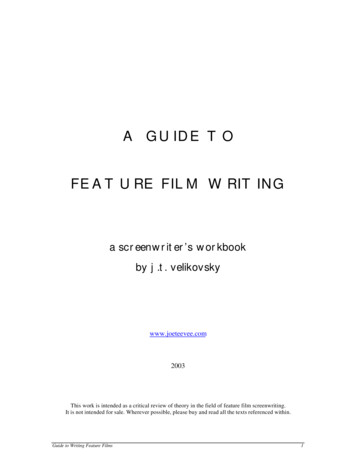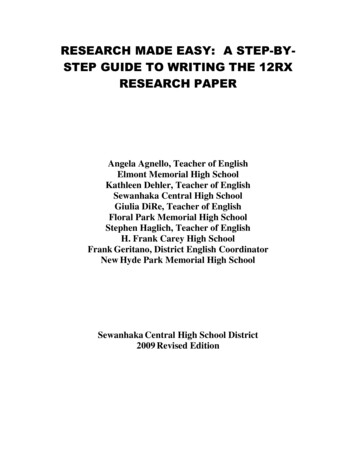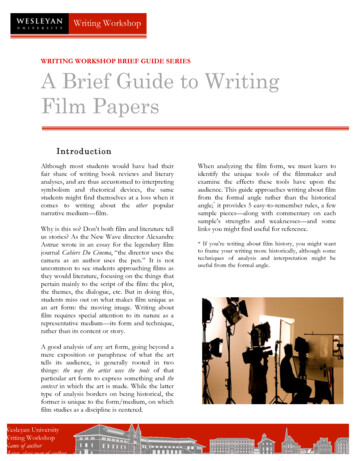
Transcription
Writing WorkshopWRITING WORKSHOP BRIEF GUIDE SERIESA Brief Guide to WritingFilm PapersIntroductionAlthough most students would have had theirfair share of writing book reviews and literaryanalyses, and are thus accustomed to interpretingsymbolism and rhetorical devices, the samestudents might find themselves at a loss when itcomes to writing about the other popularnarrative medium—film.Why is this so? Don’t both film and literature tellus stories? As the New Wave director AlexandreAstruc wrote in an essay for the legendary filmjournal Cahiers Du Cinema, “the director uses thecamera as an author uses the pen.” It is notuncommon to see students approaching films asthey would literature, focusing on the things thatpertain mainly to the script of the film: the plot,the themes, the dialogue, etc. But in doing this,students miss out on what makes film unique asan art form: the moving image. Writing aboutfilm requires special attention to its nature as arepresentative medium—its form and technique,rather than its content or story.A good analysis of any art form, going beyond amere exposition or paraphrase of what the arttells its audience, is generally rooted in twothings: the way the artist uses the tools of thatparticular art form to express something and thecontext in which the art is made. While the lattertype of analysis borders on being historical, theformer is unique to the form/medium, on whichfilm studies as a discipline is centered.Wesleyan UniversityWriting WorkshopName of authorMajor, class year of authorWhen analyzing the film form, we must learn toidentify the unique tools of the filmmaker andexamine the effects these tools have upon theaudience. This guide approaches writing about filmfrom the formal angle rather than the historicalangle;* it provides 5 easy-to-remember rules, a fewsample pieces—along with commentary on eachsample’s strengths and weaknesses—and somelinks you might find useful for reference.* If you’re writing about film history, you might wantto frame your writing more historically, although sometechniques of analysis and interpretation might beuseful from the formal angle.
25 G eneral Rules1. Pay close attention to detailWhen doing a close analysis of a scene, it is vital tobe aware of the smaller details. Different peoplehave different strategies on how to keep an eye outfor details and remember them. Some peopleprefer taking notes while watching the scene, whileothers like watching the scene once over withouttaking notes before re-watching it while jottingdown notes. Some others prefer to focus on oneparticular filmmaking tool (editing, color, framing,etc.) whenever they re-watch a scene. Whateveryour preferred method of note taking, it isimportant that your analysis reveals keen attentionto detail.The following is an example of a detailed analysisof a scene taken from a paper on Make Way forTomorrow:The camera then tracks to a closer shot ofMa as she goes to pick up a letter. We seeher look at the letter and then in the firstof several eye-line match shots, we see herPOV as she reads the letter (the fact that itis a POV shot is reinforced by the camerapanning over the letter much as eyeswould). Because we share her point ofview, we are very directly aligned with herat this point. As such, when she learns thatthe letter is from an aged women’s home,the audience learns this informationsimultaneously. The diegetic music alsosubtly shifts to a sadder tone as the camerapans to the words “Idylwild Home forAged Women,” providing us with anemotional cue. Our alignment with Mahelps us to sympathize with her and alsogives us an upper hand in the next scene,as we know that she has seen the letter, butGeorge does not.The passage above focuses on the techniques thatare used to align us with the emotions of Ma, andestablishes a hierarchy of knowledge between theaudience and the characters. Not every sceneneeds to be written in as much detail as the scenedescribed above, and for shorter papers andjournals, this might be too much.In reading and assigning most analytical film essays,instructors are not as concerned with plot andanalysis thereof. Instead, one should discuss the plotonly as it is necessary to understand the way the filmworks formally. Here we have very detaileddescriptions of camera movement, types of shotsused, use of score, and the context of the scenewithin the story. This paragraph shows how all ofthese elements work together in creating a certaineffect and establish why that is important.2. Interpret symbols not justfor the ideas they represe nt,but also for their effectsAs mentioned in the introduction, one of the mostcommon pitfalls of freshman film students isdevoting large portions of their essays tointerpreting symbolism. Not only does suchinterpretation involve a high degree of subjectivity,but analyses of film techniques lie outside of overtsymbolism. When giving students advice on thefirst test about the use of color, Professor Higginsoften warns students against interpreting colors asbeing overtly symbolic, saying, “Don’t say redmeans angry and don’t say blue means sad.” Thisis not to say that symbolic analysis has no place inthese papers—in fact it is often unavoidable— butthat one should exercise caution when doing so:one should stay away from over-simplification andcheck that one’s interpretation relates to the film’sform.Here is an example taken from an essay on Singin’in the Rain that interprets symbolism and relates itto the larger context of film: “The boldness of thecolor in this scene is a visual representation of thecoming of sound in the film industry.” Here wesee something akin to symbolism. A key phrase,however, is “visual representation.” When talkingabout film, it is more often relevant to describehow certain techniques create an emotionaleffect. So when the author above talks about howcolor is a visual representation of the coming ofsound, they don’t mean that it symbolizes this, butrather that it emphasizes and visually portrays thefeeling of the novelty of an event that is alreadyexplicit.
3The following is another example of theinterpretation of symbolism and representationfrom an essay about Make Way for Tomorrow that isappropriate for film analysis:We then see a wide shot of Rhoda dancing.This encounter continues the thread fromthe previous scene depicting theproblematic tension between the youthfulRhoda and the elderly “Ma” Cooper. Thejazz music itself is associated with youthand is shown to disturb Ma. Rhoda’sdancing is also energetic and youthful. Themise-en-scène also contributes to thistheme with the strong contrast betweenRhoda’s bright, trendy outfit and Ma’sblack, matronly dress. The director usesmise-en-scène at various points to connectto larger themes. Another example of thislater in the sequence is Ma’s rocking chair,a motif associated with old age throughoutthe film.Here we have a more explicit reference tosymbolism, where certain elements of the sceneare embodiments of a central theme. Thisexample, however, is a good example of how onecan speak about symbolism cinematically,referencing the choices of mise-en-scène by thedirector and clearly justifying the connectionsto the themes.3. Justify your analy sisIt is one thing to make a statement such as “Colorelevates the fantasy of the scene,” for a scene moreremoved from reality than the rest of the movie,and another thing to explain how it does that andwhy it is important.In explaining “how,” you have to be able to justifyhow a technique you say has a certain effectachieves that effect. So instead of saying simplythat color elevates the fantasy, it is better to saysomething like: “For most of the movie, thedirector utilizes a restrained color palette with veryfew bright colors. In this scene, however, there isan abundance of bright color separating it fromthe rest of the film visually and highlighting thefantastical nature of the scene.”Explaining why something is important is also key.Oftentimes students say that the director doessomething and this has a particular effect, but failto relate this to a larger point. It is very importantto ground the details you analyze in somelarger point about how the film or the sceneworks as a whole and not just list a string oftechniques used without unifying them in someway.4. Be specific to the filmOftentimes papers analyzing color will saysomething along the lines of “In this scene, thedirector uses color to help to direct the audience’sattention within the frame.” This kind of analysis,while true, only scratches the surface. Animportant question to ask oneself when analyzinga film is how any particular technique—such as theuse of color—is used within the unique context ofthe film in question. All of the choices made in afilm help to shape that film as a unique workof art. If Citizen Kane had been shot in color whatwould change? How would the director convey thesame emotions using different techniques andwhat would be lost or gained in the process?Basically, film essays on form should focus on howthe techniques used within a film help the directorportray a particular story and a particularemotion either in one scene or in the film as awhole. Analysis of a film should be unique to thatfilm and one should first understand what a film istrying to accomplish before one goes about tryingto understand the means by which it accomplishes(or fails to accomplish) that goal. Star Wars feelsgrand and operatic. One thing—among others—that helps it do this is the style of the score. WesAnderson films feel quirky and artificial. Hissymmetrical framing and painterly use of color arepart of this.The following is an excerpt from a film journal onMan on a Ledge, showing how analysis should befocused on the specific:Character and clarity of story trumprealism whenever necessary. The noisefrom the crowd that gathers beneath theledge is a good example. Throughout the
4first half of the film the crowd grows until itcan roar an ugly chant of “Jump JumpJump.” But this is a convenient roar thatquiets whenever characters need to talk, andrises when we need to be reminded of Nick’sdesperation. Eventually the roar changes itsattitude. The crowd decides that Nick is afolk hero to be cheered. Just when Angieneeds encouragement to crawl through aterrifyingly tight air duct, Nick can tell herover his com link that the crowd is pulling forher. The music builds, she pauses in the airduct, and then the crowd’s chants make theirway into the sound mix, implausiblypenetrating Angie’s spy-film quiet space. Itmakes no physical sense, but like the score,the crowd’s roar briefly crosses spaces andconfirms character motivation. She crawlsforward. If the film is working, then thismanipulation should go unnoticed. It allhappens again in the denouement: noise in acrowded bar fades out so that Joey canpropose to Angie. All sounds share the sameaim, the emotional engagement of the viewer.Here we see the author making a general point aboutthe film, that character and clarity of story trumprealism, and showing how this is done throughsound. The author contextualizes each moment inthe broader context of the film and describes howthe techniques used function within the particularitiesof the story being told by this movie. Thesetechniques are used in many films, but this exampleshows the uniqueness of how they are used in Man ona Ledge.5. K now your audienceYou know who will be reading your paper: yourprofessor.There are certain pedagogical purposes—other thanto decide what overall grade to award you with—your professor wants to achieve by assigning a papertopic. Thus it is important to read the prompt veryclosely. Pay attention to keywords in the promptthat tell you to do something: Analyze, Explain,Evaluate, Comment, Discuss? What, How, Why?Are there key themes and technical terms thathave been used often in lectures?The prompt should also be read in context. TheOnce you have an outline, read the prompt againand check your outline against the prompt to makesure you are on track to answering all the questionsadequately.The prompt should also be read in context. Theprofessor often has an intention for the mainthemes of a course and what he or she hopesstudents will learn. These purposes differ based onthe professor and the course agenda. Thus it isimportant to closely read and internalize what is onthe syllabus. It is good practice to re-read thesyllabus before writing a paper so as to internalizethe broad themes of the class and to remindoneself of what the professor is hoping for you tolearn.It is also good practice to go through the exampleessays in relation to the sample prompt andidentify the techniques the author used and thestyle they adopted. Compare these essays againstyour own and ask yourself: “What did thisperson do that I did not?” Don’t be too literalwhen trying to learn from these essays. A lot of theunderstanding of how to write these essays comesover time from internalizing the techniques on asubconscious level.Whether you still have doubts after reading allthese material, or think you’re ready to submityour paper, talk to your professor. Run yourideas by them. You might learn new things thatweren’t mentioned in class, or you might bechallenged with counter-arguments. This is not tosay that you should slavishly amend your ideas toalign with your professor’s; rather, you shouldconsider what different dispositions andassumptions you and your professor have, and tryas much in your paper to bridge any conceptualgaps between writer and reader—whether throughrhetoric or more nuanced consideration—in orderto make a persuasive and compelling argument. Towrite an effective paper, you have to know youraudience—and your professor is your audience.So, read the assignment prompt, the coursesyllabus, and the example essays, and talk toyour professor.
5Sample PassagesSample 1The “Good Morning” sequence in the filmdemonstrates a turning point as sound and colorbring motifs to a forefront. Just as the c
film requires special attention to its nature as a representative medium—its form and technique, rather than its content or story. A good analysis of any art form, going beyond a mere exposition or paraphrase of what the art tells its audience, is generally rooted in two things: the way the artist uses the tools of that particular art form to express something and the context in which the .
